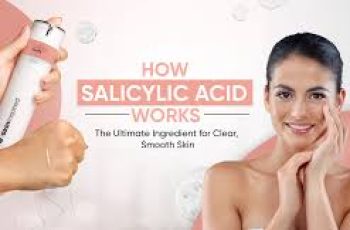
Skin Barrier Repair: 7 Expert Tips for Healthier, Stronger Skin
Your skin barrier is the unsung hero of your entire skincare routine. It’s your body’s first line of defense against environmental aggressors, pollutants, bacteria, and moisture loss. Yet, many people unknowingly damage this critical barrier with well-intentioned, but overly aggressive, skincare practices.
If your skin is feeling dry, flaky, inflamed, or suddenly ultra-sensitive, you may be experiencing a compromised skin barrier. But here’s the good news: with the right approach and a little patience, your skin can recover and even become healthier and more resilient than before.
Let’s dive into what the skin barrier really is, how to tell if yours is damaged, and—most importantly—how to repair and protect it using science-backed strategies and expert tips.
Understanding the Skin Barrier
The skin barrier, also known as the stratum corneum or lipid barrier, is the outermost layer of your skin. It’s composed of skin cells (corneocytes) bound together by lipids (fatty acids, ceramides, and cholesterol). Think of it as a brick wall, where the skin cells are the bricks and the lipids are the mortar holding everything together.
A healthy skin barrier performs several critical functions:
Locks in moisture
Protects against pathogens and allergens
Shields from UV radiation and pollution
Minimizes inflammation and irritation
When the barrier is compromised, these functions break down, leading to visible and uncomfortable symptoms.
Signs Your Skin Barrier Might Be Damaged
Before you can repair a damaged barrier, it’s crucial to recognize the signs. Common symptoms of a weakened skin barrier include:
Persistent dryness or flaking
Redness and irritation
A stinging or burning sensation when applying products
Increased sensitivity to skincare or environmental conditions
Breakouts or acne
Rosacea-like inflammation
Exacerbated eczema symptoms
If you’ve recently switched up your skincare routine or introduced multiple active ingredients (like acids, retinoids, or vitamin C), your barrier may be reacting to the overload.
What Causes Damage to the Skin Barrier?
The skin barrier is surprisingly resilient—but not invincible. Here are some common culprits that can compromise it:
Over-exfoliation (both chemical and physical)
Harsh cleansers or soaps with sulfates
Frequent use of hot water on the face
Environmental factors (UV radiation, cold wind, pollution)
Internal stressors like sleep deprivation, poor diet, and chronic stress
Incorrect product layering or mixing incompatible active ingredients
Sometimes, even well-formulated skincare can wreak havoc if used improperly or too frequently.
How to Repair a Damaged Skin Barrier: 7 Proven Tips
Now that we’ve covered the causes and symptoms, let’s get into what you can do to repair your skin barrier. These steps focus on reducing inflammation, restoring hydration, and reinforcing the lipid layer of the skin.
1. Cut Back on the “Skincare Cocktail”
When your barrier is compromised, less is more. The temptation to throw every soothing product in your cabinet at the problem may make things worse.
Start by simplifying your skincare routine. Eliminate products that contain retinoids, alpha hydroxy acids (AHAs), beta hydroxy acids (BHAs), or benzoyl peroxide, which can be too harsh during recovery. Think of this as a skincare detox—stripping back to basics to allow your skin to heal.
Use this time to assess what your skin actually needs and avoid layering multiple actives that can counteract or irritate each other.
2. Put Exfoliation on Pause
Chemical exfoliation can be amazing when used properly. However, when your skin barrier is inflamed, stop all exfoliation immediately—yes, even that gentle glycolic acid toner.
Both chemical (AHAs, BHAs, retinol) and physical exfoliants (scrubs, brushes) can worsen irritation and slow down healing. Focus on allowing your skin to naturally renew itself without extra stimulation.
When your barrier is fully recovered (typically 4–12 weeks), you can slowly reintroduce gentle exfoliation—no more than once per week to start.
3. Cleanse with Care
Cleansing is essential—but it can also be one of the most damaging steps in your routine if done incorrectly. Many traditional cleansers strip the skin of its natural oils and disrupt the acid mantle.
Avoid foaming cleansers with sulfates (like sodium lauryl sulfate), fragrance, or alcohol-based toners. Instead, opt for:
Cream cleansers
Micellar water
Gel-based cleansers with a pH between 4.5–5.5
Ingredients like glycerin, ceramides, or aloe vera
Use lukewarm water instead of hot, and limit cleansing to once or twice a day max.
4. Prioritize Moisture and Barrier Repair
Moisture is the foundation of skin barrier healing. A two-step approach works best:
Humectants like hyaluronic acid, glycerin, or urea draw water into the skin.
Occlusives and emollients like ceramides, squalane, petrolatum, shea butter, or jojoba oil seal in hydration and repair the lipid barrier.
Look for a fragrance-free, dermatologist-recommended moisturizer that contains ceramides, cholesterol, and fatty acids to mimic the natural composition of your skin’s protective layer.
Bonus tip: Apply moisturizer to damp skin right after cleansing to lock in maximum hydration.
5. Protect Against UV Radiation
Even brief exposure to the sun can worsen barrier damage, cause hyperpigmentation, and delay healing. UV rays break down collagen, weaken your lipid barrier, and increase oxidative stress.
Choose a broad-spectrum SPF 30 or higher mineral sunscreen with zinc oxide or titanium dioxide, which tend to be less irritating for compromised skin than chemical filters.
You can also add physical protection by:
Wearing a wide-brimmed hat
Using UV-protective clothing
Seeking shade between 10 AM and 4 PM
Make sunscreen a daily habit—rain or shine.
6. Focus on Internal Health and Lifestyle Habits
Your skin’s condition reflects your overall health. Making lifestyle changes that support healing can significantly enhance your barrier repair process.
Stay hydrated: Aim for 2–3 liters of water per day.
Eat anti-inflammatory foods: Fatty fish (salmon, mackerel), avocados, leafy greens, and berries are great choices.
Cut back on alcohol and smoking: Both impair skin healing and collagen production.
Get 7–9 hours of quality sleep: This is when most cellular repair happens.
Reduce stress: Chronic stress increases cortisol levels, which can worsen inflammation and skin sensitivity.
A calm mind, balanced diet, and hydrated body create an environment where your skin can thrive.
7. Soothe Inflammation with Targeted Ingredients
The final piece of the puzzle is incorporating ingredients known for their anti-inflammatory and skin-calming properties. These can help reduce redness, itchiness, and irritation.
Look for products that contain:
Niacinamide (Vitamin B3): Improves barrier function and soothes inflammation.
Centella Asiatica (Cica/Tiger Grass): A plant extract that calms redness and supports skin healing.
Colloidal Oatmeal: Great for itchy, irritated skin and common in eczema-friendly products.
Panthenol (Pro-Vitamin B5): Deeply hydrating and anti-inflammatory.
Squalane: A non-comedogenic oil that mimics your skin’s natural lipids.
Always patch test new products and introduce one at a time to avoid further aggravation.
How Long Does It Take to Repair a Damaged Skin Barrier?
Patience is key. A compromised barrier won’t heal overnight, no matter how many calming serums you apply. Depending on the severity, healing can take anywhere from two weeks to three months.
It’s also common for your skin to look worse before it gets better—this is a normal part of the recovery process. Resist the urge to switch products too quickly; consistency and minimalism will yield the best results.
Final Takeaway: Less Is More for a Stronger Skin Barrier
In our product-packed world, it’s easy to think that more is better. But when it comes to the skin barrier, simplicity is powerful. By eliminating harsh products, focusing on hydration, embracing a gentler lifestyle, and protecting your skin from the sun, you can support your skin’s natural ability to heal and defend itself.
Your skin barrier is your greatest ally—so treat it with the respect and care it deserves. Whether you’re recovering from damage or simply maintaining a healthy glow, these practices will help ensure your skin stays strong, smooth, and radiant.


